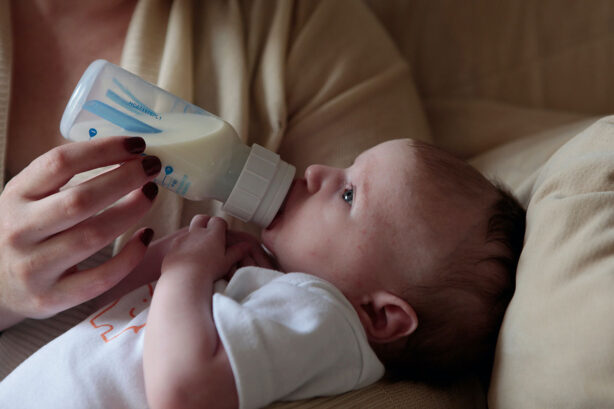Baby formula has helped keep billions of infants who are unable to breastfeed healthy and happy during their early developmental stages.
However, for first-time parents, the idea of feeding their infant anything other than breastmilk can be concerning.

That’s why knowing as much as possible about infant baby formula is a good idea. With the right knowledge about what baby formula is made out of, and how it was first developed, parents can feel confident about their feeding choice.
Start the learning with these important facts about baby formula that will arm new parents with the knowledge they need to make their infant’s first year of life a happy and healthy one:
What Exactly Is Baby Formula?
Baby formula was originally created to help feed infants that either could not be breastfed, or that needed specialized (or additional) food to stay healthy during important developmental months.
The special dietary food is constructed to simulate breast milk, and typically comes in one of three forms: powdered, concentrated liquid, or ready-to-use formula.
Powdered formula is mixed with water, and is the least expensive type of formula on the market.
Concentrated liquid formula is similar to powdered formula, but has to be measured and mixed in a more specific, almost-scientific fashion. It also tends to be more expensive than its powdered counterpart.
Finally, ready-to-use formula is pre-mixed and made for parents leading busy lives. Since it requires no extra preparation, it’s the easiest way to get a little one their bottle.

What Ingredients are Used to Make Baby Formula?
Given that baby formula is used as a substitute for human breast milk, many parents wonder what exactly formula tends to be made of.
To put it simply, there are three core ingredients that are used to make three different types of baby formula.
Firstly, cow’s milk is made to create protein-heavy formula for infants without food allergies.
Secondly, for infants that cannot properly process baby formula made of cow’s milk, plant protein or soy-based formulas are popular.
Lastly, there are hypoallergenic formulas that are specially made for infants that do not process either cow’s milk or soy-based formulas.
All three of the different formula varieties can give your infant the nutrition they need to develop in a healthy, natural way.
Deciding which one is best for your little one depends on their own preference, your budget, and any adverse reactions you might notice in your baby.

What Additional Vitamins and Minerals Boost Baby Formulas?
Although cow’s milk, soy, or plant-based proteins provide the base for infant baby formula, there are other vitamins, minerals, and trace nutrients added as well.
Biotin, choline, inositol., niacin, thiamine, riboflavin, and vitamins A, B6, B12, D, C, E, and K are some of the most common vitamins used in infant baby formula.
Calcium, copper, chloride, iodine, magnesium, potassium, and zinc make up some of the most common minerals mixed into baby formula recipes.
Lastly, lactose substitutes, fatty acids, protein substitutes, probiotics, and linoleic acid are added to give your infant complete nutrition that’s as close as possible to breast milk.
Make sure to always check with your doctor to ensure you’re getting the best formula for your individual infant’s needs, and don’t hesitate to ask about any concerns as well.
When you find a formula you love, consider buying a bulk supply; formula products will sometimes experience an availability shortage.
What’s the Difference Between Breast Milk and Baby Formula?
The big advantage of breast milk is that it’s perfectly balanced to provide your new baby with everything they need for their development.
It can be exhausting to breastfeed a baby, especially in the first few months, since newborns need to eat so often. But the physical benefits for a baby and the emotional benefits for both mother and infant make it all worthwhile.
As an added bonus, breast milk changes its nutritional makeup as your baby grows, so you know they’re always getting exactly the right balance of protein, fat, and carbohydrates they need.
But when breastfeeding just isn’t possible, modern infant baby formulas are there to ensure that your baby is getting the nutrition they need.

What Safety Precautions Should Be Taken While Using Baby Formula?
Baby formula is one of the safest products on the market in most cases, with rigorous quality and testing standards.
However, avoiding brands that have had controversies surrounding them, and knowing how to properly mix and feed the formula to your infant, are key to using formula safely.
Always use filtered, safely-sourced water when using a powdered or concentrated liquid formula, to ensure that no potentially harmful heavy minerals or bacteria end up in your baby’s system.
Additionally, always check the formula to ensure it’s the proper temperature. Never use a microwave to warm a bottle, as it can cause hot spots that could burn your baby’s mouth. Instead, put the filled bottle in a bowl of warm water for a few minutes.
If you’re using baby formula for this first time, this article from Serenity Kids on how to properly make and store formula may be helpful.
Once your baby reaches one year of age, you can safely move from formula to full-fat cow’s milk, assuming, of course, your baby hasn’t shown any sensitivities to lactose.
Here’s to a Wonderful First Year of Your Infant’s Life
With these facts about baby formula, hopefully you can now feel confident about feeding your little one, no matter what method you decide to choose.
The most important thing to remember, either way, is that as long as your baby is full and growing, you’re doing great!
